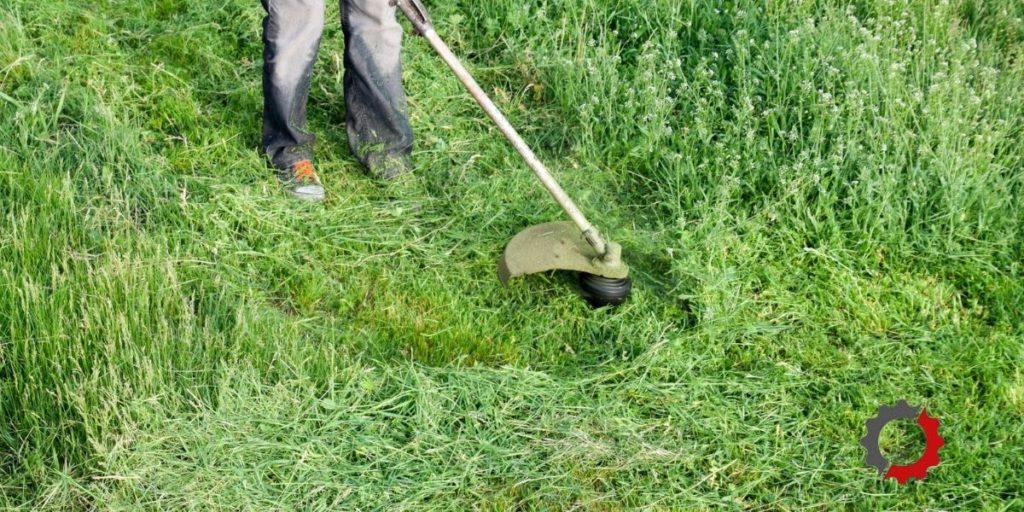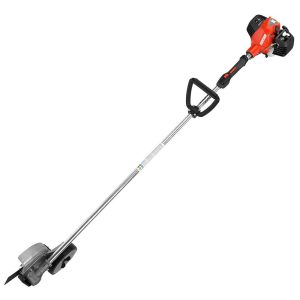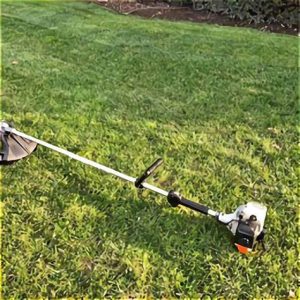13 Reasons Your Ryobi String Trimmer Won’t Start: SOLVED!
Whether you call it a weed eater, weed wacker or string trimmer, your Ryobi is an important tool for a well-manicured yard and garden. You use it to trim around your landscaping, fence posts, water features and more. When it fails to start, you need to fix it to maintain your home’s exterior appearance.
A Ryobi string trimmer will not start when the air filter is plugged, the spark plug is bad, the carburetor is dirty, old fuel restricts the fuel supply, an incorrect fuel mix is used, the wrong oil is used, the recoil starter is bad, or the engine is flooded.
Follow all safety precautions in your operator’s manual to avoid injury while working on your string trimmer. This guide references 2-cycle and 4-cycle engines.
While most Ryobi gas-powered string trimmers on the market today use 2-cycle (2-stage) engines, you will also find 4-cycle (4-stage) engines. Check your operator’s manual if you are unsure what type of engine you are running on your string trimmer.

This post may include affiliate links. Purchases made through these links may provide a commission for us, at no extra cost to you. As an Amazon Associate, we earn from qualifying purchases.
Follow all safety instructions provided in your equipment operator’s manual prior to diagnosing, repairing, or operating.Consult a professional if you don’t have the skills, or knowledge or are not in the condition to perform the repair safely.
Table of Contents
Reasons Your Ryobi String Trimmer Will Not Start
When your Ryobi string trimmer won’t start, the best thing to do is change out the maintenance items to rule these out as the potential problem. When the spark plug, air filter, and fuel filter are not regularly maintained or replaced, they can cause your string trimmer to not start or run sluggishly.
Plugged Air Filter in a Ryobi String Trimmer
An air filter is used on your Ryobi string trimmer to protect the engine from dirt and other contaminants that can damage it. The air filter should be changed out annually and cleaned regularly.
When the filter becomes dirty and plugged, sufficient air isn’t able to pass through it. The engine doesn’t get the air it needs to start and run. You may think you can resolve this by removing the filter so you don’t run into this plugged air filter problem.
This is a huge mistake. Never operate your string trimmer without an air filter, even if it is just for a short period so you can finish a task. Dirt in the engine can cause wearing and significant engine damage which may result in having to buy a new string trimmer.
Solution: Remove the filter and wipe out any remaining dirt from the air filter housing. Replace a dirty air filter with a new air filter.
Bad Spark Plug in a Ryobi String Trimmer
The spark plug is a maintenance item that should be replaced each year to keep your string trimmer running at its best. The spark plug will become dirty over time with a buildup of carbon. This can cause the plug to misfire having intermittent starting problems.
Other items to look for is cracked porcelain or burnt electrode; a loose spark plug wire; and an incorrect spark plug gap. These items can also cause a starting issue with your Ryobi.
Solution: You can attempt to clean a dirty spark plug with a wire brush and reuse it. I prefer to replace it. It is an inexpensive part and one of the primary items responsible keep your string trimmer running.
Make sure your spark plug is gapped to the manufacturer’s specification and the spark plug wire (boot) is securely attached.
Plugged Fuel Filter in a Ryobi String Trimmer
The fuel filter can be found inside the fuel tank. It attaches to the fuel line to strain the fuel before it enters the fuel system. Its function is to keep dirt and debris from getting into the fuel system that may clog the lines and carburetor damage your Ryobi trimmer.
When the fuel filter becomes plugged because it isn’t changed out regularly or you are running very dirty fuel, the amount of fuel allowed to pass through the filter is reduced. This can cause your string trimmer to fail to start because the engine isn’t getting the fuel it requires.
Solution: Locate the fuel filter inside the fuel tank and replace it.
- Wipe around the fuel cap to remove any loose dirt so it doesn’t fall into the fuel tank once you remove the cap.
- Gain access to the filter. A clean bent wire works well to “fish” the filter and pull it out of the tank.
- Remove the old filter from the fuel line. Be careful not to lose the retaining ring securing the line to the filter.
- Install the new fuel filter securing the fuel line to the filter using the retaining ring.
- Place the filter back inside the fuel tank and install the fuel cap.
Incorrect 2-Cycle Oil Mix in a Ryobi String Trimmer
Using straight gas in a 2-cycle Ryobi string trimmer will damage the engine and cause it to seize up. Adding straight gas to your string trimmer is a quick way to ruin it.
A 2-cycle Ryobi string trimmer uses gas and oil mixed at a ratio of 50:1. For example, a 50:1 mix equals 50 parts gasoline to 1 part oil.
Some old Ryobi string trimmers use a gas-to-oil mix ratio of 32:1. You can find the correct mix ratio for your model in your operator’s manual. You may also find it located on the original fuel cap.
When creating the oil and gas mixture for your Ryobi string trimmer, use unleaded gasoline with a minimum octane rating of 89 (mid-grade) and maximum ethanol content of 10%. Add a 2-cycle premium oil that is ISO-L-EGD and JASO M345 FD certified.
Mix it in an approved gas can before adding it to your string trimmer. You can use Ethanol Shield 2-cycle oil or I like this 2-cycle oil by Kawasaki. It comes in a 6.4 oz bottle that can be mixed with 2.5 gallons of gas for a 50:1 ratio.
Solution: Drain the fuel tank and fill it with the correct gas to oil mix. If you continue to have problems, have a small engine mechanic diagnose the problem and determine whether a cost-effective repair can be made.
You can find more information about the right gas to use in your Ryobi string trimmer here.
2-Cycle Premixed Fuel
A great option to reduce fuel problems and extend engine life is using an ethanol-free fuel mix. This is an ethanol-free blend of oil and fuel that is ready to pour into your string trimmer’s fuel tank.
You won’t have to deal with the bad effects of ethanol as discussed in the fuel section. Also, it’s convenient to have fuel available on your shelf when you need it. TruFuel also makes a good 50:1 premixed fuel.
Ryobi 2-Cycle Gas to Oil Mix
| Mixture | 1 Gallon Gas | 2 Gallon Gas | 2.5 Gallon Gas |
|---|---|---|---|
| 50:1 | 2.6 oz Oil | 5.2 oz Oil | 6.4 oz Oil |
| 32:1 | 4.0 oz Oil | 8.0 oz Oil | 10.0 oz Oil |
Incorrect or Insufficient Engine Oil in a 4-Cycle Ryobi String Trimmer
If you have a Ryobi string trimmer with a 4-cycle engine, you will have separate fill ports for the engine oil and fuel. You will not mix oil and fuel together for this type of engine. It’s important to use the correct engine oil and the right amount of oil.
Never use 2-cycle engine oil in a 4-cycle Ryobi string trimmer. Ryobi recommends using 20W-50 engine oil in the string trimmer. This engine oil from Kawasaki works well.
Oil is required to keep the engine components lubricated. When the wrong type or not enough oil is used, friction can build in the engine and overheat causing your string trimmer not to start and possibly ruin the engine.
Solution: Drain the engine oil and fill it with the correct oil grade. When running your trimmer in very cold or very hot temperatures, you may have to adjust the viscosity to your ambient temperature.
If you continue to have problems, have a small engine mechanic diagnose the problem and determine whether a cost-effective repair can be made.
Ryobi 4-Cycle String Trimmer Engine Oil
| Ryobi | 20W-50 (Recommended), SAE30, 10W-30, 10W-40 |
Old Fuel in a Ryobi String Trimmer
Old fuel left in a Ryobi string trimmer won’t only cause fuel restrictions, but it can also damage the carburetor and engine. Gasoline can begin to break down as quickly as 30 days after purchase.
The ethanol found in most types of gasoline attracts moisture from the air. This moisture and ethanol mixture gums up the fuel system and corrodes the components.
Because gasoline can begin to go bad as soon as 30 days after purchase, the fuel must be consumed within this time frame. If you are unable to use it in this amount of time, add a fuel additive to stabilize the fuel so it lasts a little longer.
Always use unleaded gasoline with a minimum octane rating of 89 (mid-grade) and maximum ethanol content of 10% (E10). Never use E15 or E85 in the engine as this will damage the engine and most likely void manufacturer warranties.
Solution: Drain any old fuel remaining in your string trimmer and fill it with fresh fuel. This is an oil and fuel mixture for a 2-cycle engine and unleaded gasoline for a 4-cycle engine.
Add a fuel stabilizer like Sea Foam Motor Treatment or STA-BIL to stabilize the fuel and reduce moisture in the fuel.
Bad Primer Bulb in a Ryobi String Trimmer
A cracked Ryobi primer bulb that won’t fill up with fuel won’t function correctly to get fuel to the carburetor for starting the string trimmer.
Solution: Replace with a new primer bulb.
Fuel Line Blocked in a Ryobi String Trimmer
Old fuel sitting in your string trimmer can leave a gummy sticky deposit behind that restricts fuel flow. This can clog the fuel line and restrict the fuel flow your string trimmer requires to start.
Solution: Replace a fuel line on your Ryobi string trimmer when it is cracked, kinked, or clogged.
Plugged Fuel Tank Vent in a Ryobi String Trimmer
The fuel tank vent allows air into the tank. Without a vent, the fuel tank will create a vacuum that won’t allow fuel to flow through the string trimmer.
A good indication you may have a fuel tank vent problem is when your string trimmer runs for a few minutes and then shuts down and won’t start until you remove or loosen the fuel cap to allow air into the fuel tank.
When you tighten the cap and allow it to run and the string trimmer dies and fails to start until the cap is loosened, you most likely have a fuel vent problem.
Solution: Replace the fuel tank vent so the air can flow into the fuel tank. Most likely, the fuel tank vent (sometimes referred to as a check valve) is located in the cap on a Ryobi string trimmer.
Dirty Carburetor on a Ryobi String Trimmer
The carburetor regulates the amount of fuel that is mixed with air to create a combustion in the cylinder. Old fuel will gum up and clog the carburetor so it no longer functions properly.
Solution: If you are a little mechanical you should be able to handle cleaning your carburetor. Clean the carburetor by taking it apart and using carburetor cleaner to clean it.
If the carburetor does not function after being cleaned, you may need to rebuild it or replace it with a new carburetor.
Depending on the model string trimmer you run and the price of a carburetor, it may be best to invest in a new Ryobi string trimmer rather than put money towards replacing a carburetor on an old trimmer.
Bad Recoil Starter on a Ryobi String Trimmer
Your Ryobi string trimmer uses a recoil to start the engine. A bad pulley; loose or missing spring; or broken clips can keep your recoil from working.
Solution: You can attempt to replace the spring and restring the recoil. If it does not work because other components in your recoil are damaged, such as the clips or the pulley, you are better off just replacing the recoil assembly.
Bad Spark Arrestor in a Ryobi String Trimmer
You will find a spark arrestor in your Ryobi string trimmer that can prevent it from starting. The spark arrestor is a small screen that can get plugged with soot.
Solution: Disconnect the spark plug boot. Make sure your engine is not hot. Remove the engine cover and engine exhaust cover.
Remove the spark arrestor and clean it with a wire brush to remove the soot. If you are unable to clean it sufficiently or it is broken or has a hole in it, replace it with a new spark arrestor.
Flooded Ryobi String Trimmer
I have had customers bring their string trimmer to the repair shop because they can’t get it started. Many times it’s due to a flooded engine which isn’t too serious.
The engine can become flooded when the choke is in the closed position and the starter rope was pulled many times allowing too much gas into the carburetor.
It can also happen with the switch off and the starter rope being pulled multiple times or when the primer bulb is pushed too many times.
Solution: Use the following procedure to “unflood” your string trimmer so the engine gets the correct fuel-to-air ratio required to start and run.
How to Fix a Flooded Engine on a Ryobi String Trimmer
- Move the choke lever to the run position.
- Press the throttle trigger while pulling the starter rope over and over. This can take anywhere between 5 and 15 pulls before it starts. Your string trimmer engine will sputter first. Continue to pull a few more times and it should start.







